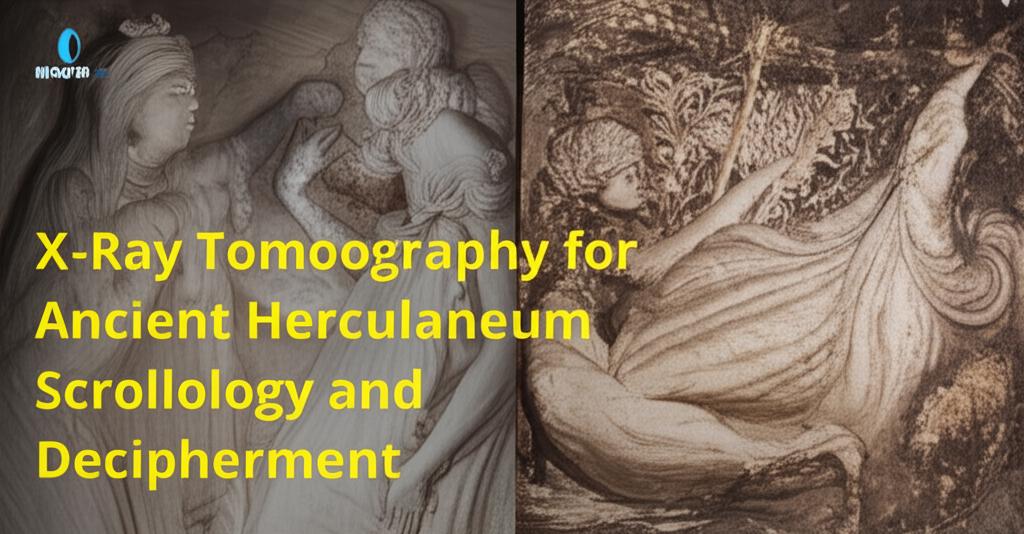Unlocking Ancient Secrets: X-Ray Tomography and AI Decipher Herculaneum Scrolls
The ancient Herculaneum scrolls, tragically buried by the eruption of Mount Vesuvius in 79 AD, are steadily yielding their secrets thanks to a powerful combination of X-ray tomography and artificial intelligence. These carbonized papyri, too fragile to physically unroll, have long been a tantalizing mystery for historians and classicists. However, recent technological advancements, spurred significantly by the Vesuvius Challenge, are now enabling researchers to "virtually unwrap" and read these ancient texts.
The Technology: Peering Inside with X-Rays and AIThe core of this groundbreaking work lies in using high-resolution X-ray tomography, often conducted at synchrotron facilities like the Diamond Light Source in the UK. These powerful X-ray beams, in some cases 10 billion times brighter than the sun, can penetrate the charred scrolls and create detailed 3D digital models of their internal structure. This process, often referred to as "virtual unwrapping," allows scientists to map the delicate, rolled layers of papyrus without causing further damage.
Once these 3D scans are created, the next challenge is to detect the faint traces of ink. The ancient ink, typically carbon-based, is chemically very similar to the carbonized papyrus, making it extremely difficult to distinguish. This is where artificial intelligence and machine learning come into play. Sophisticated AI algorithms, many developed and refined through the Vesuvius Challenge, are trained to identify the subtle differences in density or texture that indicate the presence of ink. This process, known as segmentation, digitally "paints" the ink onto the virtual layers of the scroll. Some scrolls, like PHerc. 172, have ink with a higher density, possibly due to contaminants like lead, which makes it more visible to X-ray scans and aids the AI's decipherment capabilities.
The Vesuvius Challenge: Accelerating DiscoveryLaunched in March 2023 by Dr. Brent Seales of the University of Kentucky and Silicon Valley sponsors, the Vesuvius Challenge has been a pivotal force in this field. By offering substantial prizes, the challenge has incentivized a global community of researchers, computer scientists, and students to develop and improve the AI tools needed for decipherment. In 2023, a team of students won the grand prize for successfully identifying over 2,000 Greek letters from one scroll. The challenge continues with new prizes aimed at reading entire scrolls and identifying titles or first letters.
Recent Breakthroughs and Deciphered TextsSignificant progress continues to be made. As of early 2025, researchers have successfully generated the first clear images from inside scroll PHerc. 172, housed at the Bodleian Libraries at Oxford. Early decipherments from this and other scrolls have revealed words in ancient Greek, including "πορφύρας" (porphyras - purple), ἀδιάληπτος ('foolish'), διατροπή ('disgust'), φοβ ('fear'), and βίου ('life'). The content of one scroll has been identified as a philosophical text, likely Epicurean, discussing pleasure, music, food, and the senses. Scholars are working to transcribe and translate these newly revealed texts, which are providing unprecedented insights into ancient thought and literature, potentially including previously unknown works.
The Future of Herculaneum PapyrologyWhile current AI technology excels at ink detection, the interpretation and translation of the text still rely heavily on human papyrologists. The ongoing efforts focus on automating and refining the virtual unwrapping pipeline, improving the AI's ability to handle different ink compositions and papyrus conditions, and ultimately, reading the entirety of the hundreds of scrolls recovered from Herculaneum. Researchers are optimistic that 2025 could be a landmark year, with the potential to substantially read an entire scroll for the first time. This revolution in Herculaneum papyrology promises to unlock a wealth of knowledge from the ancient world, offering a direct window into the minds of philosophers and writers from nearly two millennia ago.

